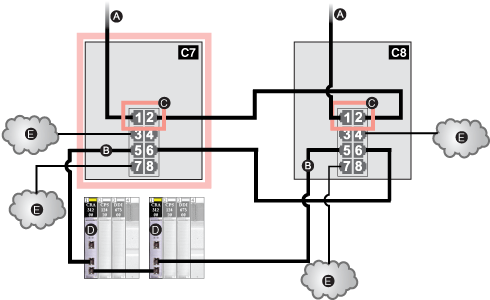Predefined Configuration File Name
C7_Master_RIOMainRing_RIOSubRing_DIOCloudsVx.xx.cfg, where
Vx.xx references the version number of the file.
Use of this Predefined Configuration
A key reason for using the Quantum EIO architecture is to put some or all of your remote I/O drops on sub-rings. The remote I/O drops on the sub-rings are controlled by the PLC on the main ring the same way as remote I/O drops connected directly to the main ring. The sub-ring architecture lets you extend the distance between consecutive remote I/O drops and isolate the devices and cables on a sub-ring from those on the main ring and on other sub-rings.
With this predefined configuration, use 2 — one installed with this
master predefined configuration and the other installed with the corresponding
slave predefined configuration (
C8) — to provide a redundant connection between the main ring and the sub-ring. The
master DRS passes data between the main ring and the remote I/O sub-ring. If the
master DRS becomes inoperable, the
slave DRS takes control and passes data between the main ring and the remote I/O sub-ring.
NOTE: When a master slave becomes inoperable, a slave DRS assumes the primary role in less than 50 ms. Refer to the Comparison of Master/Slave Configuration and Auto Configuration to determine what roles the master and slave DRSs resume if the master DRS becomes operational again.
NOTE:
DRS inner ports are the 2 ports on the switch that are connected to the main ring. When using 2 DRSs, connect the designated master inner ports to the designated slave inner ports.
-
For copper port master and slave DRS redundant configurations, the inner ports are port 2 for the main ring and port 6 for a sub-ring.
-
For copper/fiber port master and slave DRS redundant configurations, the inner ports are port 3 for the main ring and port 6 for a sub-ring.
If you are using a single DRS but plan to convert to redundant configurations in the future, make a note of these port configurations to minimize any schematic changes required because of the conversion.
Devices Supported and Restricted in this Predefined Configuration
The predefined configuration described here is for a TCSESM083F23F1 ConneXium extended managed switch, which has 8 copper connection ports and no fiber port connections.
A remote I/O sub-ring can contain only approved Schneider Electric remote I/O devices, e.g., a •••CRA312•0 remote I/O adapter in a Quantum or Modicon X80 remote I/O drop.
Distributed I/O devices, such as TeSys T motor drives and islands of STB devices, can be connected to switch ports that are not reserved for main ring and remote I/O sub-ring connections. Each cloud uses only one DRS port connection. You cannot use this predefined configuration to connect distributed I/O devices directly on the sub-ring.
You cannot use a redundant pair of DRSs to connect a sub-ring to another sub-ring.
Do not connect any devices between the master DRSs and the slave DRS on the main ring or the sub-ring. Install the DRSs next to each other — within 100 m.
Predefined Port Connections
Use the 2 top ports (shown as 1 and 2 in the following graphic) for main ring (A) redundant connections. Use ports 5 and 6 for the remote I/O sub-ring (B) redundant connections.
Ports 3, 4, and 7 are configured for connecting distributed I/O clouds to the network. Port 8 is reserved for
port mirroring: i.e., for monitoring the status of the ports you previously selected in the switch’s port mirror web page.
NOTE: The default configuration of port 8 has port mirroring disabled.
C7
master DRS using a C7 predefined configuration file acting as the primary redundant connection between the main ring and the remote I/O sub-ring
C8
slave DRS using a C8 predefined configuration file acting as the standby redundant connection between the main ring and the remote I/O sub-ring
A
DRS connections to the main ring
B
DRS connections to the remote I/O sub-ring
C
DRS inner ports (The master and slave DRSs are linked together via port 2. Ports 1 are linked to the main ring.)
D
remote I/O drops with 140CRA31200 adapter modules
E
distributed I/O clouds
|
Port
|
Type
|
Description
|
|
1
|
100Base-TX
|
copper main ring redundant connections
|
|
2
|
100Base-TX
|
|
3
|
100Base-TX
|
distributed I/O cloud connections
|
|
4
|
100Base-TX
|
|
5
|
100Base-TX
|
copper remote I/O sub-ring redundant connections
|
|
6
|
100Base-TX
|
|
7
|
100Base-TX
|
distributed I/O cloud connections
|
|
8
|
100Base-TX
|
port mirroring connection
|
NOTE: When you download this DRS predefined configuration file to a switch, the file provides a set of operating parameters that enable the switch to operate with high efficiency in the specified architecture.
Do not adjust the configuration parameters or alter the port usage from what is shown above. Changing the configuration parameters or the port assignments can compromise the effectiveness and accuracy of the switch and the performance of the remote I/O network.
You can enable/disable port mirroring and change the selection of the source ports that you want mirrored. Port mirroring is disabled by default. The destination port is set to port 8, and ports 1-7 are selected as source ports. Do not change the destination port. When using port mirroring, select the ports, for which you want to analyze the traffic, as the source ports. When you finish troubleshooting, disable port mirroring.
